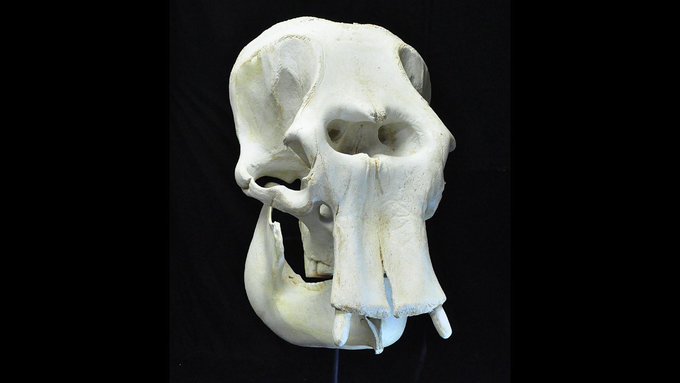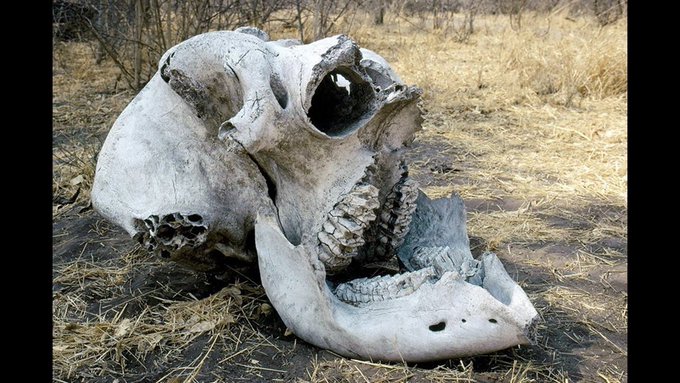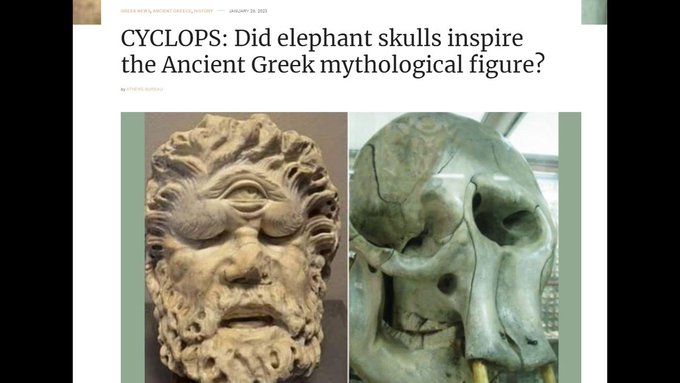We can all imagine how our ancestors thought they saw impossible creatures like dragons, or unicorns, or bigfoot, but did you know that these creatures existed once to some degree? Let's uncover the real beasts that inspired these legends, and some that have even been caught on camera.
Cyclops
Over 2,000 years ago, the Greek poet Homer wrote the Odyssey, which follows the adventures of Odysseus. Among his exploits was his arrival on an island populated by a terrifying race of one-eyed man-eating giants, known as cyclopes. Odysseus and his crew were held captive by the cyclops Polyphemus, until they escaped with a bit of trickery and eye gouging.
The Odyssey’s a great myth, but is there any evidence that these cyclopic giants existed in real life? Well, along the Mediterranean islands, people have actually discovered the skulls of huge one eyed monsters, which seem to back up the myth!
But testing revealed these skulls actually belonged to dwarf elephants; distant relatives of modern elephants that roamed the Mediterranean long before the arrival of humans, until their extinction around 400,000 years ago. An adult grew to about 3 feet tall, no bigger than an African elephant calf, while their own calves were the size of puppies. How could they have inspired the
beastly cyclopes? In the center of an elephant’s skull lies the nasal passage, where the animal’s trunk would have been. Over time, this would rot away, leaving behind a hollow cavity. Before the 4th-century, most Greeks had never encountered elephants. So, if they stumbled upon these fossils, they could have mistaken the hole for an eye socket, leading them to believe it came from a cyclops.
With all the other extraordinary things the Greeks believed in, like Medusa, the Minotaur, or Cerberus, it's unlikely that they’d have batted an eye at the existence of cyclopes!
Unicorns
The unicorn is a mystical legendary beast, but it wasn’t always the beautiful horned horse that we use in emojis or put on lattes today. The first mention in Western literature of this creature comes from the Greek physician Ctesias in the 4th century BCE. He relayed stories from Indian travelers of a large, pale blue-eyed donkey, with a crimson head and three horns of white, red, and black.
Ctesias's animal could well be the original unicorn or Satan, though it seems that this creature was actually a descriptive combination of large herbivores, such as the chiru, kiang, and Indian rhino. In 77 AD, Roman author Pliny the Elder gave his own description of the unicorn, a ferocious one-horned beast, impossible to capture alive, though he was probably describing the Indian rhino. So the radiant unicorn was partly inspired by big, smelly rhinos?
In the 3rd century BC, scholars translating the Hebrew Bible to Greek mixed up Re'em with monokeros, meaning one horn, previously used for rhinos. Before they knew it, this became unicornus in Latin and unicorn in English, leading the creature to become a symbol of purity and Jesus Christ. As for that swirled horn, this came about during the Middle Ages, when sailors and merchants peddled spiraled horns to European markets, claiming they were taken from slayed unicorns.
People believed these possessed mystical powers, such as the ability to purify water and heal the sick. In reality, these were the tusks of narwhals, an Arctic whale species with an enlarged tooth that grows around 6 to 9 feet long from the animal’s head. Royalty and aristocrats, unaware narwhals even existed, eagerly purchased the tusks. In fact, the throne of Denmark, constructed in 1660, is made with exposed unicorn horn.
Owlman & Mothman
Back in 1976, the Melling family went on an Easter vacation to Cornwall, England. It was a trip to remember, for all the wrong reasons. They were staying in the village of Mawnan, and their two girls were playing near the local church.
Suddenly, they heard a noise coming from above, and when they looked up, they saw a horrific, twisted shape hovering over the church’s tower. It was a dark feathered creature, the same size as a man, but with outstretched wings, and giant eyes that were far too big for any man’s head.
The girls fled, and severely shaken, they told their father, who in turn recounted the incident to local sage Tony ‘Doc’ Shiels. After this, more people were said to be terrorized by the Cornish creature, coined
The Owlman, across the late 70s and 80s, and each told their stories to Doc, who wrote and inspired books based on Owlman. Its legend haunts the South of England, but over the pond in a small village called Point Pleasant, in West Virginia, USA, a similar freak can be found in local folklore. Point Pleasant was a TNT area, somewhere factories that produced explosives for World War II. After the war, TNT was still being stored on site, supposedly polluting the surrounding environment. This led locals to speculate about what sort of effects it might have on the wildlife. In 1966, two couples came running out of the woods, claiming they’d seen something monstrous; a humanoid figure, with 10-ft wings and gigantic, glowing red eyes:
the Mothman. The local paper ran the story, which riled the entire town up to go hunting for it. This saw it pass from story to legend, with people claiming to this day they’ve caught the creature on camera! So, what were they really? If these really were humanoid, then the wings would need to be able to generate as much upward lift as the humanoids weight, so if Owlman and Mothman were both 5 ½ ft tall, say, then their wingspan would need to be around 22 ft. That’s a lot bigger than Mothman’s 10 ft span. Perhaps what these people mistakenly saw was a large species of owl, like the
Eurasian eagle owl. You see, the larger female of the species can measure up to about 30 inches long with a wingspan of over 6 ft!
Just one problem with that theory: the species isn’t present in the UK or the US. But it’s not unheard of for avian adventurers to get lost and arrive from mainland Europe. They could’ve also been large barn owls, which are very creepy when they hiss like this in the clip below:
Barn Owl hissing by MrRelhed Owls aren’t the only explanation though. All of the Owlman stories came from people who spoke to Doc, or one of his acquaintances, and then vanished. For context, Doc is a self-proclaimed warlock, famous for his tall tales. There isn't a single news report on the Owlman, so chances are, he conjured up the whole thing! However, Mothman did have multiple newspapers run stories about the sightings, which included the names and addresses of the people who’d seen it. But this was at a time where UFO and alien fever had gripped the nation, maybe their imaginations got carried away?
Kraken
Of all the sea monsters lurking in the ocean depths, one of the most terrifying has to be the kraken. The legend originates from the waters of Scandinavia, where seafarers would return home with tales of a gigantic monster, as big as an island, that preyed on unwary ships.
Throughout the ages, the kraken’s appearance has varied from a formless blob to a giant crustacean. It was only in the 18th century that the image we have today, a giant squid or octopus with tree-sized tentacles, emerged.
The inspiration for the giant squid-like kraken likely stemmed from sightings of giant and colossal squids! These are massive cephalopods over 40 feet in length, that’s bigger than your average school bus! The colossal squid sticks to Antarctic waters, whereas giant squids are found nearly everywhere, bar polar and tropical regions. Here’s one in 2015 that showed up in Toyama Bay, Japan:
Raw: Giant Squid Makes Rare Appearance in Bay by Associated Press The giant squid tips the scales around a hefty 600 pounds, while the colossal squid dwarfs even that, weighing up to 1,100 pounds, which is about as heavy as a grizzly bear! Even as late as 2004, people have had kraken-like experiences firsthand. French sailors participating in the Jules Verne Trophy race reported
an encounter with a kraken-like squid. Crewman Olivier De Kersauson recounted how the creature latched onto their vessel's hull, only releasing its grip when the ship came to a halt.
There’s only been about 250 sightings of giant squid ever recorded, mostly involving deceased specimens washed ashore. This is because they live at depths of some 3,280 ft, and there’s been even fewer sightings of the colossal squid, which live at depths as low as to 6,560 ft. Live encounters with these animals are very rare, though after hearing stories of krakens attacking crews, maybe that’s a good thing!
Griffins
A legend from the 5th century BC tells of the Greek historian Herodotus embarking on a journey towards central Asia. As he crossed the Gobi desert in Mongolia, he encountered the Scythians; nomadic people who shared tales of fierce creatures with beaks and four legs, guarding caves brimming with gold and protecting their young.

Those creatures sound just like griffins! Wild beasts with the head, front legs, and occasionally wings of an eagle, coupled with the hindquarters of a lion. Coincidentally, the Gobi desert boasts one of the richest fossil deposits in the world, which is where the remains of the Protoceratops can be found. This dinosaur lived 80 million years ago during the Late Cretaceous period and was an ancestor of the more famous triceratops. This herbivorous creature measured 6 ft long, and weighed 400 lbs, so about the same size as a very large wild boar. Classical folklorist Adrienne Mayor hypothesized that the Scythians, while mining for gold, may have unearthed Protoceratops remains, sparking the griffin myth; both have beaked bird-like faces, yet walk on four legs like a mammal.

But not everyone buys this. Beasts with falcon-heads and lions bodies appeared in motifs from ancient Egypt as early as the 2nd millennium BC, around 2,000 years before Herodotus. It’s much more likely that when Greeks started trading with the Middle East in the 8th century BC, they picked up new styles of art and religion. That’s when mythical creatures, like griffins, were adopted into Greek culture. As for the Scythians, maybe they just told Herodotus the griffin story to stop him pinching their gold!
Sea Serpents
What if you saw a sea snake over a mile long? Myths of gigantic sea snakes have spanned cultures worldwide, from the South Asian Naga gods, to the Japanese Ryūjin, to the Norse Jörmungandr.
One of the most infamous sightings comes from the fishing town of Gloucester in Massachusetts in the US. Between 1817 and 1819, reports of a strange creature, dubbed the Gloucester Sea Serpent, came flooding in. Descriptions varied wildly, but almost all reports referred to its immense size and snake-like head!
This might have been a basking shark. When viewed from a boat, these 40-feet long fish slip through the water just like a serpent. It wouldn’t be the first time one of these goliaths has been mistaken for the mythical creature. In 1808, the 55 ft long carcass of a
basking shark washed up on Stronsay, in the Orkney Islands, Scotland. Its immense size led locals to believe it was the remains of a sea serpent. The basking shark isn’t the only contender for this monstrous title, though.
In January 1860, what was believed to be a sea serpent washed up on Hungry Bay in Bermuda, turned out to be an oarfish. They disturbingly lack scales and have red hair-like filaments growing along their bodies! The sea creature holds the title for the world’s longest bony fish alive, measuring up to a gigantic 50 feet long! Although their elusive nature makes them difficult to study, as they tend to live between 65 and 650 ft below, only really breaching the water’s surface when they’re ill or are about to die.
Dragon
Legends of these creatures have been with us since the late 2nd millennium BC in Mesopotamia, though these early dragons were depicted as being thinner and more snake-like. It was only in Europe after the 8th century that they evolved into winged, four-legged beasts. The fire-breathing likely came about when Christians associated dragons with Satan and hellfire.
On the other side, you’ve got east Asian dragons. These serpentine creatures are wise, often associated with water, and are generally chill. So, what animal inspired these creatures? It’d be easier to ask what animal didn’t inspire them. Whenever early people found fossils left behind by gigantic animals, their imagination, understandably, conjured up terrifying monsters. Take, for instance, the city of Klagenfurt, Austria, where the town hall displayed a skull believed to be from a
lindwurm; a snakish dragon slain by a knight.
To honor the legend, a statue was carved with the skull used as a reference. However, in the 1800s, zoologists discovered it was actually from, a woolly rhino. Surprisingly, rhinos were mistaken for both unicorns and dragons. What’s more, in 16th century China, a medical guide created by a court physician described a medicine made from dragon bones, which were in reality,
fossils. However, these may’ve been from Dinocephalosaurus orientalis, a 16 ft long aquatic reptile from the Triassic period. In the image below, its serpentine body looks unmistakably similar to that of traditional Chinese dragons, which have no wings, and instead are fabled to swim through the air!
Though it’s not just fossils that stoke legends of this distinct-looking creature. In 2017, villagers in Zhangjiakou, in China's northern Hebei Province claimed to have found a
60 ft long dragon skeleton! While it did resemble the fossil structure, and had a number of locals convinced dragons walked among them, it was actually a movie prop though the structure and scale of it was still impressive! Another, more psychological theory is that dragons sprang from the human mind as a combination of all the predators our ancestors would’ve feared, such as big cats, snakes, crocodiles, and birds of prey. If all the early dragons were depicted as large snake-like beings, it doesn’t seem like a stretch to say they might have been inspired by, well, large snakes!
Shapeshifting Foxes
Picture this: you’ve fallen for that special someone only for the love of your life to reveal they’re actually a fox in disguise! Weirdly, it’s a tale as old as time in East Asian folklore, where fox spirit myths thrive. Whether it be the Chinese húli jīng, the Japanese kitsune, or the Korean gumiho, all have stories telling of their shapeshifting powers, as well as their ability to sport over a thousand tails.
The number of tails supposedly reflected a fox's age and status, the more tails, the older, wiser, and more powerful they were, with nine being the most common. These myths often involve foxes taking on the guise of a beautiful woman. In China, when a fox woman seduced a man, she would feed off his yang energy, weakening the man and even killing him!
Not all foxes were bad news; in Japan, some were messengers of Inari, a god of harvest and land in the Shinto religion, and were depicted as pure white. There was no distinction between ordinary
red foxes and paranormal ones. Apparently, everyday foxes were simply not old enough to possess supernatural powers. It was the animals’ tendency to appear at twilight that contributed to them being seen as liminal beings, ones that existed within two worlds: the regular and the spirit.
Kappa
If you’re ever frolicking in the rivers of Japan, locals will say you must watch out for the kappa. This is a goblin-like water spirit, about the same size as a child. It's covered in scales, has webbed hands, shaggy hair, and a depression at the top of its head filled with water, just like a bowl.
Its behavior ranges from kind, to mischievous, to downright murderous! They even have a penchant for sucking the insides out of a person’s butthole. This sounds too bizarre to be real, but some claim there’s evidence this demon exists; in 2014, so-called
mummified remains of the creature went on display at the Miyakonojo Shimazu Residence after it was supposedly shot on a riverbank in 1818. The story is not believable. Either these remains are fake, or they belong to an animal with similar appendages, like the giant Japanese salamander. This is the second-largest salamander in the world, weighing up to 55 lbs, and growing up to 5 ft long, that’s the same as a 10-year-old child! Unlike kappas, salamanders avoid humans, and reports of them attacking people are rare. What they are aggressive towards is their prey. The way salamanders snap their heads as they chomp down on their catch may have startled onlookers, inspiring the mythical creature. However, the kappa looks more like a really big frog, toad, or turtle. Maybe the myth was conjured up by parents to stop their children from getting too close to the water, by making up a butt-sucking monster.
Chupacabra
Starting in the mid-1970s, farmers across Puerto Rico awoke to a gruesome scene: their livestock had been slaughtered, their blood drained, and some even slit open. Witnesses reported a strange creature prowling in the dark, with sharp fangs and glowing eyes.
The carnage grew and spread across Latin America and the southern USA throughout the 80s and 90s, where the culprit became known as
El Chupacabra, the goat sucker. The most famous account comes from Madelyne Tolentino in Canóvanas, back in August 1995, who claimed she saw the monster roaming her street.
She described it as being some 3 ft tall at the shoulder, with human hands, big eyes, no nose, and greyish skin that looked like wet leather covered in rough patches of hair. The sketches that came from that description were truly unhinged, leading some to believe the creature must have been from outer space, or the result of a secret government experiment.
However, chupacabra are likely just coyotes suffering from a severe skin condition called mange. This is when parasitic mites burrow under the host’s skin, releasing eggs and waste, causing an inflammatory response from the immune system. The animal’s fur begins to fall out, and the skin becomes covered in sores, giving it a scaly appearance. The condition is severely debilitating for canines, and infected coyotes are forced to prey on easy targets, such as livestock, in order to survive.
Mangy canines might not be the only inspiration; Tolentino, along with other witnesses, said that the chupacabra bore a resemblance to the alien villain in the sci-fi horror film Species, released that same year. Maybe Tolentino’s overactive imagination exaggerated an infected coyote’s spikiness, giving it an extraterrestrial appearance.
Mountain Men
Ape-human hybrid myths have been proliferated all over the world: from the European wild man, to the majestic Himalayan yeti. But the most famous of all has to be the North American Bigfoot, or Sasquatch, whose legend traces back to indigenous folklore. The word Sasquatch reportedly comes from the Canadian Sts’ailes nation who believed in the shapeshifting sasq’ets.
Even today, people still claim they have proof that they exist in the wild. Just take a look at this peaceful car ride through Bashkortostan, Russia in 2016:
Yeti in Russia? Thoughts? by J Despite spooky phenomena like this, sceptics have dismissed stories of ape-men as a load of hooey. However, in 1935, the discovery of an unusually large molar tooth in Hong Kong gave credence to bigfoot believers. Since then, fossilized jaws and teeth of a gigantic prehistoric ape have been found in China, Vietnam, and India. They belonged to
Gigantopithecus, a relative of the orangutan.
This extinct ape lived about 12 to 8 million years ago, stood more than 10 feet tall, and weighed 1,200 pounds. The animal lived in Asia some 12 to 8 million years ago, spending its days lumbering on all fours and feeding on vegetation. Cryptozoologists, people who search for legendary creatures whose existence isn't proven, have argued that the relatives of the Gigantopithecus may still live in places where these ape-men are reported. Though other bigfoot aficionados have dismissed these claims, arguing that bigfoot is agile and two-legged, rather than a 10-foot-tall orangutan.
Centaur
Centaurs were a fabled race of creatures from Greek mythology, part human, part horse, that dwelled in the mountains of Thessaly and Arcadia. There are a few stories about how centaurs came into being, none of them are child-friendly. One version involves a character called Centaurus getting friendly with some mares, resulting in the centaur race.
Over-familiarity with animals aside, it's obvious that there weren’t really half-human, half-horse beings galloping around, but they were possibly inspired by a real-life sight. Back in the early classical period, that’s the time from 510 to 323 BC, people didn’t ride horses. So when Scythian horsemen, nomadic warriors from the East, came raiding, terrified Greeks might have mistaken the rider and horse as one creature.
Similar effects happen when horse-riding cultures come into contact with those who don’t ride. When the Spanish conquistadors invaded Mexico, the indigenous Aztecs and Incas believed the animal and human to be a single creature.
However, that may not be the only reason for these man-imals.
Terracotta figures of humans with horse hindquarters were discovered in the Mycenaean city of Ugarit, in modern day Syria, during the late Greek Bronze Age. The Greeks may have snagged this motif by interacting with other civilizations in the east, whether through war, trade, or travel. I hope you were amazed at the mythical creatures that exist in real life, in a way or another! Thanks for reading.







































